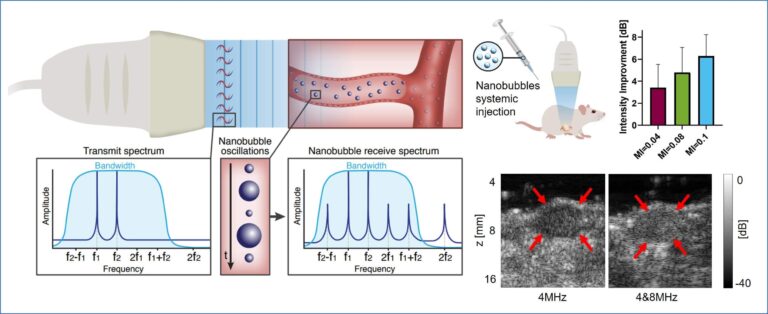Nanoscale nanobubbles represent the next generation of ultrasound contrast agents, offering enhanced stability and improved tumor penetration following systemic injection. Nevertheless, their small size poses echogenicity challenges, limiting diagnostic effectiveness.
We introduce a nanobubble frequency mixing ultrasound imaging method, in order to address their inherent echogenicity limitations. This effect occurs when a bubble is simultaneously excited by multiple frequencies, and this research demonstrates for the first time that nanobubbles also exhibit this effect. Our unique transmission signal combines two frequencies in real time within a standard pulse-inversion sequence for contrast harmonic imaging and is transmitted by a programmable ultrasound system. Due to the frequency mixing nanobubble effect from their nonlinear acoustic response to dual-frequency excitation, new frequencies are generated mainly in the nanobubble echoes (i.e. the sum and difference frequencies), which amplify their acoustic signal and improve their diagnostic efficacy. The method employs a broadband transducer without requiring extra hardware or post-processing.
Imaging was performed with a broadband transducer (L12-3v). Optimization experiments were performed to identify the optimal combination of transmitted frequencies and found to be 4&8MHz. In the tissue-mimicking phantom experiments, nanobubble contrast was improved with an increased mechanical index for all values that were tested. Maximal contrast improvement was 8.4±0.5 dB for a mechanical index of 0.1 compared to a 4MHz single frequency transmit. In a breast cancer tumor mouse model, the systemic injection of nanobubbles using our method resulted in a contrast improvement of 6.3 dB compared to standard imaging.
In conclusion, frequency mixing with nanobubbles may facilitate ultrasound imaging applications for cancer diagnosis and monitoring.

